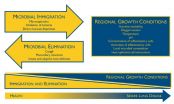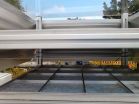(Press-News.org) ANN ARBOR, Mich. - One of the most common complaints about hospitals is the noise. Patients complain that they can't sleep soundly in the environment of multiple monitors, paging systems, wheelchairs and gurneys, and carts that squeak.
Ongoing efforts at the University of Michigan Health System are making the hospital quieter, and the hospital has tested sound panels designed to dial down noise.
During a pilot study, strategically placed sound acoustic panels helped diffuse sound in the hallways around patient rooms. The modest 3-4 sound decibel drop is recognizable to the human ear and consistent with a fall in noise generated by a car slowing down from 80 mph to 60 mph.
"In hospital environments where noise levels are often double what they should be according to the World Health Organization's standard decibel guidelines for patient rooms, the difference is significant," says Mojtaba Navvab, Ph.D., associate professor of architecture and design at the Taubman College of Architecture and Urban Planning at the University of Michigan.
Navvab is partnering with U-M Architecture, Engineering and Construction, which plans spaces across three U-M campuses, on room acoustic research, and collaborated with physicians Peter M. Farrehi, M.D., and Brahmajee K. Nallamothu, M.D., on the noise reduction study.
The diffusion methods tested at the U-M Health System are similar to methods used at recording studios, rehearsal rooms and concert halls to control sound.
Four custom panels, covered in cones and made with sound-absorbing material, were installed for three days in the walls and ceilings of a cardiovascular care unit.
Sound levels were 60 decibels during the daytime, according to the study findings published in BMJ Quality and Safety, but on hallways with the sound panels, the hospital was a bit quieter at 57 decibels.
"This architectural design could complement on-going strategies for addressing noise," says Farrehi, study co-author and cardiologist at the U-M Health System. "The panels help diffuse sound, rather than attempt to eliminate the sounds generated in a modern hospital environment."
The negative side of noise
Research reveals that a noisy environment doesn't just make patients unhappy -- it can also prompt spikes in blood pressure and interfere with wound healing and pain management. And it affects those who work with and near patients.
In fact, studies have shown a direct correlation between sound decibel levels in work environments and employee blood pressure levels and heart rates.
Hospital noise is ranked low on the Hospital Consumer Assessment of Healthcare Providers and Systems (HCAHPS), and those scores can impact hospital reimbursement. Patients who are dissatisfied with the noise in their rooms are often significantly less satisfied with their overall hospital experience.
Promoting a culture of quiet
To reduce hospital noise, the U-M Hospitals and Health Centers is using several strategies intended to enhance the patient care experience and also improve working conditions for employees.
UMHS promotes a culture of quiet on behalf of patients, families and employees by:
Providing complimentary ear buds, headphones and earplugs for patients and their families.
Keeping hallway conversation to a minimum, especially at night.
Establishing quiet hours in all inpatient areas.
Encouraging patients and staff to respect others by turning down the volume on cell phones, televisions, radios, pagers and other devices
Minimizing cell phone conversations in hospital hallways and waiting rooms and encouraging others to do the same.
Setting pagers to vibrate when medically appropriate.
Dimming lights in patient rooms and unit hallways.
Coordinating care in order to reduce unnecessary entry into patient rooms during quiet hours.
Reminding staff to use quiet voices and behaviors in the patient care setting.
Closing doors quietly.
Providing a "white noise" TV channel in all patient rooms.
Wearing soft sole shoes to minimize hallway noise outside patient rooms.
Placing work orders through a dedicated system to have noisy carts, doors and other items repaired.
Scheduling floor cleaning times that don't conflict with nighttime resting hours.
Testing meters that indicate sound levels in some patient rooms.
INFORMATION:
When researchers dream about electronics of the future, they more or less dream of pouring liquids into a beaker, stirring them together and decanting a computer out onto the table. This field of research is known as self-assembling molecular electronics. But, getting chemical substances to self-assemble into electronic components is just as complicated as it sounds. Now, a group of researchers has published their breakthrough within the field. The group consists of first-year nanoscience students from the University of Copenhagen.
Thomas Just Sørensen, an associate ...
This news release is available in German. Two growth-promoting groups of substances, or phytohormones, the gibberellins and the brassinosteroids, are used independently of each other for the breeding and production of crop plants. A team of scientists at Technical University of Munich (TUM) has now discovered that the two act in concert - without brassinosteroids, a plant is unable to produce gibberellins.
For their current investigations, a research group at the Technical University of Munich, supported by scientists from the Helmholtz Zentrum Munich and the TU Braunschweig ...
ANN ARBOR, Mich. -- With every breath you take, microbes have a chance of making it into your lungs. But what happens when they get there? And why do dangerous lung infections like pneumonia happen in some people, but not others?
Researchers at the University of Michigan Medical School have started to answer these questions by studying the microbiome of the lungs - the community of microscopic organisms are in constant contact with our respiratory system.
By studying these bacterial communities, and how they change in illness, they hope to pave the way for new ways ...
Troubling questions about multiracial congregations' potential to address racial inequality are raised by a new national study done by researchers at Baylor University, the University of Southern California and the University of Chicago.
The study -- "United by Faith? Race/Ethnicity, Congregational Diversity, and Explanations of Racial Inequality" -- is published in the journal Sociology of Religion.
"We find little evidence that multiracial congregations promote progressive racial views among attendees of any race or ethnicity," the researchers wrote. Views of minorities ...
BOSTON, Aug. 17, 2015 --Native North Americans have long adorned themselves and their homes with fragrant sweetgrass (Hierochloe odorata), a native plant used in traditional medicine, to repel biting insects, and mosquitoes in particular. Now, researchers report that they have identified the compounds in sweetgrass that keep these bugs at bay.
The team will describe their approach in one of more than 9,000 presentations at the 250th National Meeting & Exposition of the American Chemical Society (ACS), the world's largest scientific society, taking place here through Thursday.
Mosquitoes ...
BOSTON, Aug. 17, 2015 -- Hand-written letters and printed photos seem quaint in today's digital age. But there's one thing that traditional media have over hard drives: longevity. To address this modern shortcoming, scientists are turning to DNA to save unprecedented amounts of digital data for posterity. One team has demonstrated that DNA they encapsulated can preserve information for at least 2,000 years, and they're now working on a filing system to make it easier to navigate.
The researchers present their work today at the 250th National Meeting & Exposition of the ...
BOSTON, Aug. 17, 2015 -- A blood clot is a dangerous health situation with the potential to trigger heart attacks, strokes and other medical emergencies. To treat a blood clot, doctors need to find its exact location. But current clinical techniques can only look at one part of the body at a time, slowing treatment and increasing the risk for complications. Now, researchers are reporting a method, tested in rats, that may someday allow health care providers to quickly scan the entire body for a blood clot.
The team will describe their approach in one of more than 9,000 ...
BOSTON, Aug.17, 2015 -- In a first-of-its-kind study, researchers have determined that natural sunlight triggers the release of smog-forming nitrogen oxide compounds from the grime that typically coats buildings, statues and other outdoor surfaces in urban areas. The finding confirms previous laboratory work using simulated sunlight and upends the long-held notion that nitrates in urban grime are "locked" in place.
The scientists will present their findings based on field studies conducted in Leipzig, Germany, and Toronto, Canada, at the 250th National Meeting & Exposition ...
New Internet-based technology may aid criminal justice agencies through tools such as better criminal databases, remotely conducted criminal trials and electronic monitoring of parolees in the community, according to a new RAND Corporation study.
Top criminal justice priorities for new Internet tools include developing a common criminal history record that can be shared across agencies, developing real-time language translation tools and improved video displays for law enforcement officers to adapt to changing needs, according to the analysis.
"The criminal justice ...
During the deer's breeding season, or rut, the researchers from Queen Mary University of London (QMUL) and ETH Zürich, played male fallow deer (bucks) in Petworth Park in West Sussex, a variety of different calls that had been digitally manipulated to change the pitch and length and analysed their responses. The bucks treated lower pitched and longer calls as more threatening, by looking towards source of the call sooner and for longer, than others.
Fallow bucks attracted the attention of the researchers because of their intriguing calling behaviour. Males are silent ...




